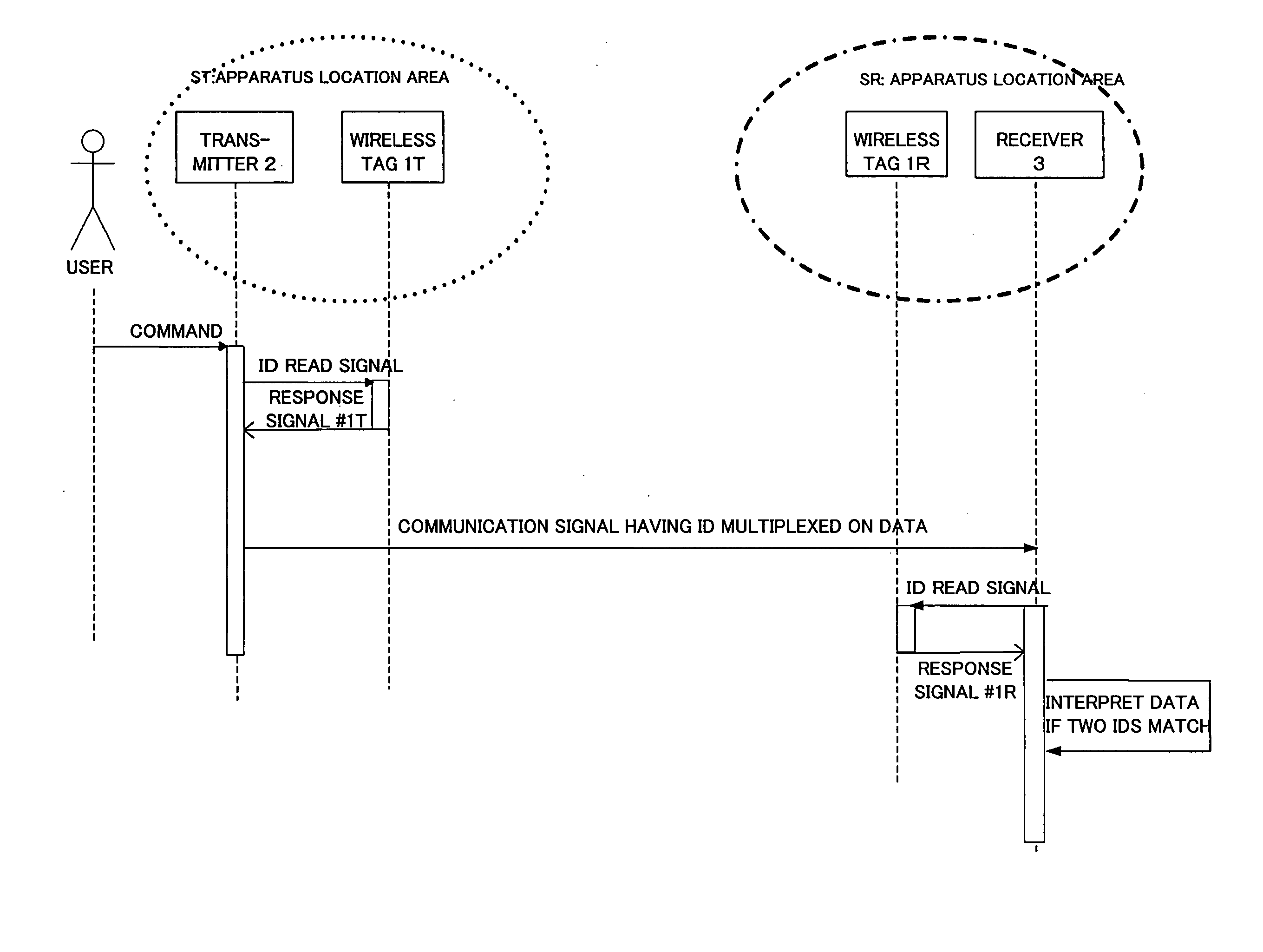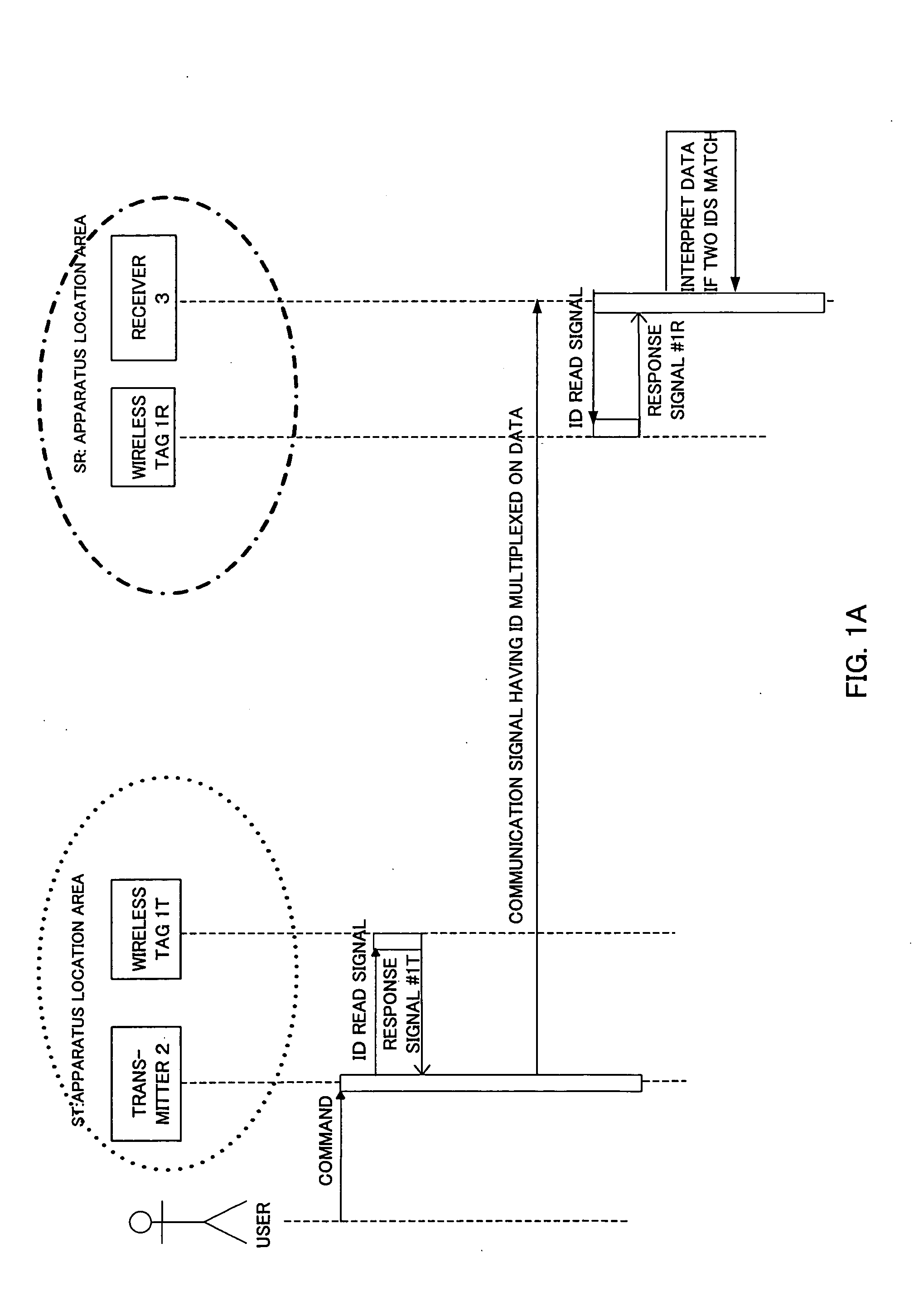Communication system
a communication system and communication technology, applied in the field of communication systems, can solve the problems of holding on to the above, and achieve the effect of low field intensity and low field intensity
- Summary
- Abstract
- Description
- Claims
- Application Information
AI Technical Summary
Benefits of technology
Problems solved by technology
Method used
Image
Examples
first embodiment
[0053]FIGS. 1A and 1B illustrate a communication system according to the present invention. In FIG. 1A, 1T and 1R denote wireless tags which are disposed at arbitrary locations such as on a ceiling, a wall, a floor, a desk and the like in buildings, and the numerals 2 and 3 denote a transmitter and a receiver. The wireless tags 1T and 1R store the same ID. The transmitter 2 transmits an ID read signal before transmitting data, and extracts an ID from a received response signal #1T returned from the wireless tag 1T in response to the ID read signal, multiplexes the read ID on the data to be transmitted, and transmits the data multiplexed with the ID. The receiver 3 in turn transmits an ID read signal upon receipt of a signal, extracts an ID from the signal, extracts an ID from a response signal #1R returned from the wireless tag 1R in response to the ID read signal, and compares the ID in the received signal with the ID read from the wireless tag 1R. In a case that the both IDs match...
third embodiment
[0076] Generally, a wireless tag can store a limited length of ID (the number of bytes of an encoded value(s)), so that when a long ID is necessary, it is necessary that it be divided. However, if one ID is simply divided into k sections which are assigned to and stored in k wireless tags, all the k wireless tags must be provided in each area (the transmitter location area or receiver location area) in order to restore the original ID. Further, when read errors of the wireless tags are taken into consideration, k wireless tags are not sufficient, and a number of wireless tags approximately twice as the value of k must be provided in the area. On the contrary, when the FEC coding is applied as in the present invention, a much smaller number of wireless tags are required proportional to expected read errors, as compared with the simple division of the ID.
[0077] In addition, when all wireless tags placed near the transmitter and receiver have different IDs, it is necessary to store a l...
second embodiment
[0093] According to the present invention, the foregoing problems can be solved as described below. FIGS. 6A and 6B illustrate an exemplary solution in which the present invention is applied to a remote control system for a television receiver set. It should be noted, however, that a transmitter location area matches with a receiver location area in this remote control system.
[0094] In FIGS. 6A and 6B, TV receiver sets 3A, 3B are placed in adjacent rooms A and B, respectively, and a remote control unit 2A can be used commonly for the TV receiver sets 3A and 3B. Wireless tags 1T1A, 1T2A, 1R1A, and 1R2A are fixed at locations such as on a wall surface, a ceiling, a floor, or the like of the room A, while wireless tags 1T1B, 1T2B, 1R1B, and 1R2B are fixed in a similar manner. While FIG. 6A illustrates an example in which four wireless tags are installed in each room, the number of the wireless tags is not limited to four, but an arbitrary number of wireless tags may be installed in eac...
PUM
 Login to View More
Login to View More Abstract
Description
Claims
Application Information
 Login to View More
Login to View More - R&D
- Intellectual Property
- Life Sciences
- Materials
- Tech Scout
- Unparalleled Data Quality
- Higher Quality Content
- 60% Fewer Hallucinations
Browse by: Latest US Patents, China's latest patents, Technical Efficacy Thesaurus, Application Domain, Technology Topic, Popular Technical Reports.
© 2025 PatSnap. All rights reserved.Legal|Privacy policy|Modern Slavery Act Transparency Statement|Sitemap|About US| Contact US: help@patsnap.com



